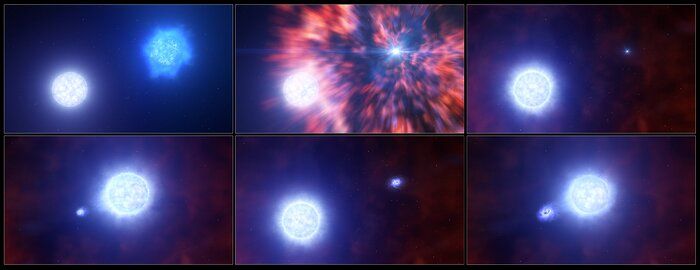Astronomers have discovered the stellar “missing link” that directly connects a massive star’s death to the birth of a black hole or a neutron star.
Two teams of scientists made the discovery using the Very Large Telescope (VLT) and the New Technology Telescope (NTT) to look at supernova wreckage designated SN 2022jli, which was discovered in May 2022. Lurking in the spiral arm of the relatively close galaxy NGC 157, located 75 million light-years away from Earth, SN 2022jli demonstrated peculiar traits distinguishing it from other supernovas.
While most supernovas simply fade in brightness after the initial explosion that marks the death of a star that has run out of fuel for nuclear fusion at its core, SN 2022jli’s brightness declines regularly, but not smoothly, instead “jumping” up and down every 12 Earth days or so.
This light oscillation appears to be the result of a black hole or neutron star whipping through the puffed-out atmosphere of a surviving star among the gas cloud supernova wreckage, stealing matter as it does so.
Related: Star-birthing galaxies can hide supermassive black holes behind walls of dust
“In SN 2022jli’s data, we see a repeating sequence of brightening and fading,” study leader and Queen’s University Belfast scientist Thomas Moore said in a statement. “This is the first time that repeated periodic oscillations, over many cycles, have been detected in a supernova light curve.”
Astronomers have previously spotted indirect evidence of the link between destroyed massive stars and super-dense stellar remnants like neutron stars and black holes. One such example is the presence of a neutron star at the heart of supernova wreckage called the Crab Nebula, created when a star exploded nearly a thousand years ago.
However, this new research is the first direct evidence of a connection between supernovas and black holes or neutron stars.
The discovery was presented at the 243rd American Astronomical Society meeting in New Orleans on Tuesday, Jan. 9, by the leader of one of the teams of astronomers, Weizmann Institute of Science researcher Ping Chen.
Companion star is a witness to a massive star murder mystery
Both teams of scientists behind the observations of SN 2022jli think that the strange oscillating brightness behavior of this supernova happens as a result of a companion star existing alongside the exploded massive star, making this a binary star system.
While binary star systems are not exceptional, especially for massive stars, what makes this system really special is the fact that the supernova death of the system’s massive star hasn’t kicked away or destroyed its companion star and that the two objects remain in orbit around each other.

Using the X-shooter instrument on the VLT and a variety of other astronomical instruments, the team led by Chen made additional observations as well as spotting the regular fluctuations in the visible brightness of SN 2022jli. This led to them also seeing periodic movements in hydrogen gas in the system and powerful bursts of high-energy light called gamma rays.
When all this evidence is combined, it suggested to the two research teams that when the system’s companion star interacted with the material blasted out by the supernova death of its stellar sibling, the hydrogen envelope of the surviving star “puffed out.”
The black hole or neutron star in SN 2022jli is passing through this swelled-out layer, pulling away material with its gravitational influence. This material formed a disk of matter around the compact stellar remnant and the snatching process is releasing energy responsible for the periodic flashes in brightness observed by the two teams.
For the researchers, this theft of matter and energy from the companion star confirms the presence of a neutron star or black hole that is attracting matter to itself, even though this dense stellar remnant can’t be seen directly.
“Our research is like solving a puzzle by gathering all possible evidence. All these pieces lining up lead to the truth,” Chen concluded.
Even if the presence of a neutron star or black hole in this supernova wreckage can be confirmed, the SN 2022jli system is still unique. That means it holds further mysteries for astronomers to investigate with the next generation of telescopes, such as the Extremely Large Telescope currently under construction in Northern Chile.
The missing link supernova research was published in two papers featured in Nature and the Astrophysical Journal Letters.